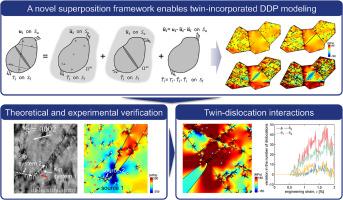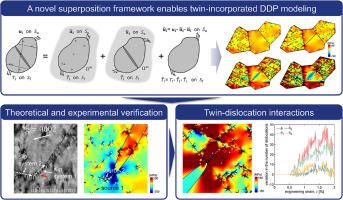Investigation of twin-dislocation interactions using a novel discrete dislocation plasticity framework
IF 12.8
1区 材料科学
Q1 ENGINEERING, MECHANICAL
引用次数: 0
Abstract
Twinning-induced strain localization fundamentally governs a material’s ductility and failure mechanisms, complementing the role of dislocation slip in hexagonal close-packed crystals. This localization not only accommodates externally applied deformation through stress redistribution but also generates heterogeneous stress that significantly influences nearby dislocation evolution. In conventional dislocation-scale modeling approaches, such as discrete dislocation plasticity (DDP), twinning is typically represented by introducing twin boundaries and regions with reoriented crystal lattices. These models, however, often neglect the associated strain fields generated during the twinning process, resulting in an incomplete description of twinning-dislocation interactions. To address this limitation, a novel DDP model incorporating twin-induced heterogeneous deformation was developed. The model explicitly includes different stages of twinning, such as nucleation, propagation, and growth, and implements the twin-induced stress field using the classical Eshelby inclusion solution. A new superposition framework was further constructed to capture these stress contributions within the DDP formulation accurately. Based on this model, the experimentally observed characteristic twin-induced dislocation arrays in single crystals and bicrystal were successfully reproduced. Moreover, through comparison with the twin-free model, twin-dislocation interactions in polycrystals were quantitatively analyzed, demonstrating the capability of the model to resolve complex plasticity mechanisms across different microstructures.


用新的离散位错塑性框架研究双位错相互作用
孪晶引起的应变局部化从根本上控制了材料的延展性和破坏机制,补充了位错滑移在六方密排晶体中的作用。这种局部化不仅通过应力重分布适应外部施加的变形,而且还产生非均质应力,显著影响附近位错的演变。在传统的位错尺度建模方法中,如离散位错塑性(DDP),孪生通常通过引入具有重定向晶格的孪晶边界和区域来表示。然而,这些模型往往忽略了孪晶过程中产生的相关应变场,导致对孪晶-位错相互作用的描述不完整。为了解决这一限制,开发了一种新的包含双诱导非均质变形的DDP模型。该模型明确地包含了孪生的不同阶段,如成核、扩展和生长,并使用经典的Eshelby夹杂解实现了孪生诱发应力场。进一步构建了一个新的叠加框架,以准确捕获DDP公式中的这些应力贡献。基于该模型,成功地再现了实验中观察到的单晶和双晶中特征性的双致位错阵列。此外,通过与无孪晶模型的比较,定量分析了多晶中的孪位错相互作用,证明了该模型能够解决不同微观结构的复杂塑性机制。
本文章由计算机程序翻译,如有差异,请以英文原文为准。
求助全文
约1分钟内获得全文
求助全文
来源期刊

International Journal of Plasticity
工程技术-材料科学:综合
CiteScore
15.30
自引率
26.50%
发文量
256
审稿时长
46 days
期刊介绍:
International Journal of Plasticity aims to present original research encompassing all facets of plastic deformation, damage, and fracture behavior in both isotropic and anisotropic solids. This includes exploring the thermodynamics of plasticity and fracture, continuum theory, and macroscopic as well as microscopic phenomena.
Topics of interest span the plastic behavior of single crystals and polycrystalline metals, ceramics, rocks, soils, composites, nanocrystalline and microelectronics materials, shape memory alloys, ferroelectric ceramics, thin films, and polymers. Additionally, the journal covers plasticity aspects of failure and fracture mechanics. Contributions involving significant experimental, numerical, or theoretical advancements that enhance the understanding of the plastic behavior of solids are particularly valued. Papers addressing the modeling of finite nonlinear elastic deformation, bearing similarities to the modeling of plastic deformation, are also welcomed.
 求助内容:
求助内容: 应助结果提醒方式:
应助结果提醒方式:


